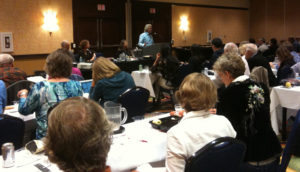Moderated by Jan Newton, NANOOS, panel members Andrew Dickson, California Current Acidification Network, Libby Jewett, Director, NOAA Ocean Acidification Program, and Jean-Pierre Gattuso, Laboratoire d’Océanographie de Villefranche led discussion on current and future ocean acidification monitoring efforts from regional, national and international perspectives
Supported by the Gordon and Betty Moore Foundation through a grant to University of California, San Diego.
Session summary:
C-CAN (the California Current Acidification Network), together with the NOAA Ocean Acidification Program, hosted a lunchtime meeting on September 26, 2012, in a side meeting affiliated with the Oceans in a High CO2 World conference. The roundtable discussion drew a standing-room only crowd to hear presentations by panel members (Andrew Dickson, UC San Diego; Libby Jewett, NOAA; and Jean-Pierre Gattuso, LOV, Villefranche), who provided regional, national and international perspectives on the state of OA monitoring and plans for the future. Following panel presentations, moderator, Jan Newton, U Washington, entertained questions and comments from the audience. The focus of the presentations and discussions was on the practicalities of planning and implementing an effective ocean acidification observing network.
Andrew Dickson described the work of the C-CAN group (an ad hoc regional collaboration of academic scientists, commercial fishing and aquaculture interests together with state and federal resource managers) who came together in an effort to better understand the drivers of ocean acidification along the US West Coast, and its likely impacts on organisms along the coast (see http://c-can.msi.ucsb.edu). A key problem identified by C-CAN was that most current carbon chemistry data along the US West Coast are unsuitable for the needs of C-CAN stakeholders. For example, the carbon chemistry is often not measured at locations that coincide with biological studies and existing measurements are not of uniform quality. The immediate goal is therefore to establish a network of observations along the US West Coast that can provide a picture of what is happening (with regard to the CO2 system) in the locations where the organisms of interest are living. This will better inform biological studies, and could enable improved management practices.
To achieve this, C-CAN is seeking resources to work to lower the barriers to making seawater CO2 measurements of sufficient quality by providing explicit guidance as to how best to make such measurements, and also to develop the necessary data infrastructure (perhaps in collaboration with the regional associations of IOOS) for combining the various individual data sets produced into a coherent network.
Libby Jewett provided a broader national perspective of ocean acidification observing planning, based largely on a recent workshop held at the University of Washington
(http://www.pmel.noaa.gov/co2/OA2012Workshop/WorkshopHome.html). This detailed the broad range of environments to be studied (both around the shores of the US and further afield) and the wide range of observing assets that may be used for this. She noted that workshop participants had indicated that there would be two distinct goals for such observations: first understanding the physical and chemical conditions of the environment (with, perhaps, some limited bio-optical information); second, and less clearly laid out as yet, there is an undoubted need to assess the ecosystem response to changes in these conditions. Some of this work is being supported by NOAA presently, much is still in the planning stages.
Finally, Jean-Pierre Gattuso described some of the lessons that had been learned from the EPOCA program, and described briefly the new Ocean Acidification International Coordination Centre which will be based at the IAEA in Monaco and overseen by an international advisory board. In particular he emphasized the role of the new center in establishing and promulgating “best practices” as well as in encouraging an increase in observing capacity around the world.

The presentations, questions, and discussion helped to emphasize the current status of ocean acidification observing over these various scales. There is broad agreement that simple chemical and physical variables such as salinity, temperature, oxygen, and CO2 chemistry should be measured in any ocean acidification observing network, however there is no consensus as to the suite of biological parameters that should be considered integral to ocean acidification observations. Indeed it was felt that these might well vary depending on the ecological system under study.
Essentially the field is in its infancy and, as yet, there is insufficient capacity to make the geographically extensive measurements even of physical and chemical parameters that will be needed. The various panel members and many of the audience reiterated the need to address this need in the near future, particularly on a regional basis.